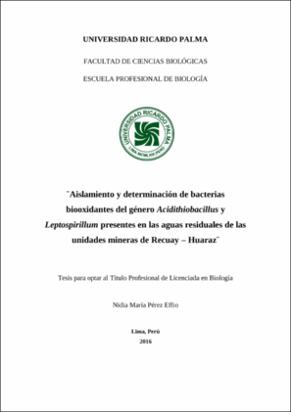Mostrar el registro sencillo del ítem
Aislamiento y determinación de bacterias biooxidantes del género Acidithiobacillus y Leptospirillum presentes en las aguas residuales de las unidades mineras de Recuay – Huaraz
| dc.contributor.advisor | Quiñones Aguilar, Mauro | |
| dc.contributor.author | Pérez Effio, Nidia María | |
| dc.date.accessioned | 2017-05-31T17:00:01Z | |
| dc.date.available | 2017-05-31T17:00:01Z | |
| dc.date.issued | 2016 | |
| dc.identifier.uri | https://hdl.handle.net/20.500.14138/914 | |
| dc.description.abstract | La presente investigación tuvo como objetivo el aislamiento y determinación de las bacterias del género Acidithiobacillus y Leptospirillum presentes en las aguas residuales de las unidades mineras de Recuay – Huaraz. Con este fin se recolectaron 3 muestras del efluente y se llevaron al laboratorio donde fueron sometidas al enriquecimiento en medios de cultivo 9K y TK líquidos, con un pH de 1.5 y se realizó un conteo poblacional cada 24 horas haciendo uso de la cámara de Newbauber. Se obtuvó la mayor concentración bacteriana en el tratamiento 1 con 9.33E+06 cel/ml durante la etapa de enriquecimiento. Por otro lado, para el aislamiento del cultivo se utilizó medio 9K líquido y sólido; el primero fue incubado a temperatura ambiente por 8 días. Transcurrido este tiempo se sembró en placas Petri, por estría y por extensión. En medio sólido 9K con agar-agar se observó crecimiento bacteriano después de 14 a 25 días, en el 50% de placas sembradas por extensión y el 10% por estría. Mientras que en el medio cultivo 9K con agarosa se observó crecimiento después de 7 a 8 días en el 80% y 60% de placas por extensión y estría, respectivamente. Los resultados de la observación microscópica mostraron presencia de bacterias con morfología bacilar, carácter acidófilo por su desarrollo en medios con pH 1.5 y metabolismo quimiolitiotrofo por su crecimiento y mantenimiento durante el tiempo del ensayo a expensas de compuestos inorgánicos presentes en el medio. En el medio sólido con crecimiento bacteriano después de 45 días de incubación se logró diferenciar 3 tipos de colonias que coinciden con el género de Acidithiobacillus . Además se obtuvieron indicios de las biotransformaciones realizadas por las bacterias lixiviadoras, oxidando el sulfato ferroso a sulfato férrico durante la determinación de bioxidación, lo cual se evidenció mediante el cambio de color de verde traslúcido a naranja brillante.The present investigation had as objective the isolation and determination of the species of the genus Acidithiobacillus and Leptospirillum present in the waste water of the mining units of Recuay - Huaraz. To this end, 3 samples of the effluent were collected and taken to the laboratory where they were submitted to enrichment in 9K and T & K liquid culture media, with a pH of 1.5 and a population count was done every 24 hours using the Newbauber chamber. The results showed that the best enrichment was carried out with the medium 9k in agitation 150 rpm, extra aeration and heat 40 ° C, as the bacterial growth curve occurred in ascending and sustained form, being at 432 hours where Observed the highest bacterial concentration, 9.33E + 06 cells / ml. On the other hand, liquid and solid 9K medium were used for the isolation of the culture; The first was incubated at room temperature for 8 days. After this time was planted in Petri plates, by stria and by extension. In solid 9K medium with agar-agar bacterial growth was observed after 14 to 25 days, in 50% of plates seeded by extension and 10% by streak. While in the 9K medium agarose culture growth was observed after 7 to 8 days in 80% and 60% plates by extension and stria, respectively. The results of the microscopic observation showed the presence of bacteria with bacillary morphology, acidophilic character due to their development in media with pH 1.5 and chemiolithotroph metabolism due to their growth and maintenance during the time of the test at the expense of inorganic compounds present in the medium. In solid medium with bacterial growth after 45 days of incubation it was possible to differentiate 3 types of colonies. In addition, indications were obtained of the biotransformations performed by the leaching bacteria, oxidizing the ferrous sulfate to ferric sulfate during the determination of biooxidation. Which was evidenced by the change of color from translucent green to bright orange. | es_ES |
| dc.description.uri | Tesis | es_ES |
| dc.format | application/pdf | es_ES |
| dc.language.iso | spa | es_ES |
| dc.publisher | Universidad Ricardo Palma | es_ES |
| dc.rights | info:eu-repo/semantics/openAccess | es_ES |
| dc.source | Universidad Ricardo Palma | es_ES |
| dc.source | Repositorio institucional - URP | es_ES |
| dc.subject | Minería | es_ES |
| dc.subject | quimiolitiotrofico | es_ES |
| dc.subject | Acidithiobacillus | es_ES |
| dc.subject | Biomining | es_ES |
| dc.subject | chemiolithotrophic | es_ES |
| dc.subject | Acidithiobacillus | es_ES |
| dc.title | Aislamiento y determinación de bacterias biooxidantes del género Acidithiobacillus y Leptospirillum presentes en las aguas residuales de las unidades mineras de Recuay – Huaraz | es_ES |
| dc.type | info:eu-repo/semantics/bachelorThesis | es_ES |
| thesis.degree.discipline | Biología | es_ES |
| thesis.degree.grantor | UNIVERSIDAD RICARDO PALMA. FACULTAD DE CIENCIAS BIOLÓGICAS | es_ES |
| thesis.degree.level | Título Profesional | es_ES |
| thesis.degree.name | Para optar el grado de Licenciado en Biología | es_ES |
| dc.publisher.country | PE |
Ficheros en el ítem
Este ítem aparece en la(s) siguiente(s) colección(ones)
-
Biología [161]

